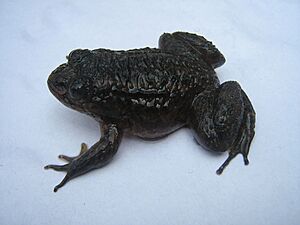Dattatreya night frog facts for kids
Quick facts for kids Dattatreya night frog |
|
|---|---|
 |
|
| Conservation status | |
| Scientific classification |
The Dattatreya night frog (its scientific name is Nyctibatrachus dattatreyaensis) is a special kind of frog. It belongs to a family called Nyctibatrachidae. Scientists first found this frog in 2008. They discovered it in the Shola forests. These forests are near a place called Dattatreya Peeta in the Chikkamagaluru district of Karnataka, India. This frog has only ever been found in this small area of the Western Ghats mountains.
Contents
What Does the Dattatreya Night Frog Look Like?
This frog is about 40 millimeters long. That's about the size of a large paperclip! It has a head that is wider than it is long. Its skin on its back is very wrinkled. It has three long folds on its back.
Colors and Markings
The Dattatreya night frog has two yellowish stripes. These stripes are on its sides. They are easy to see when the frog gets older. Its eyes are a bright golden yellow. They have black pupils that look like diamonds. The top of its body can be reddish-black or stone black. It also has two yellow bands on its sides.
Special Features
This frog has special glands on its thighs. These are called femoral glands. Male frogs also have a noticeable thumb pad. These features are very clear in adult males. The frog's toes have medium webbing. This means the skin between its toes covers about three-quarters of their length.
Where it Hides
The Dattatreya night frog is active at night. During the day, it likes to hide. It often stays under small rocks. It also hides in damp leaf litter. You can find it near slow-moving streams. These streams are in the Shola forests.
How Was This Frog Discovered?
Scientists from the Zoological Survey of India found this frog. They discovered it in 2008. They named it Nyctibatrachus dattatreyaensis. This name comes from the Dattatreya shrine. The shrine is in the same area where the frog lives.
Where Does the Dattatreya Night Frog Live?
The Dattatreya night frog is only found in a few places. These places are all in the Chikkamagaluru district of Karnataka, India. You can find it near Dattatreya Peeta. It also lives in the Bhadra Wildlife Sanctuary. Other spots include Kemmangundi and Baba Budangiri.
Why is This Frog in Danger?
The Dattatreya night frog is in big trouble. It is listed as "critically endangered". This means it is very close to disappearing forever.
Threats to its Home
The hills where this frog lives are known for medicinal plants. People often collect these plants without permission. This activity harms the frog's habitat. Many tourists also visit the area. This "ecotourism" puts a lot of pressure on the environment. The water source for the Manikyadhara Falls is also at risk. All these problems make it hard for the Dattatreya night frog to survive.


